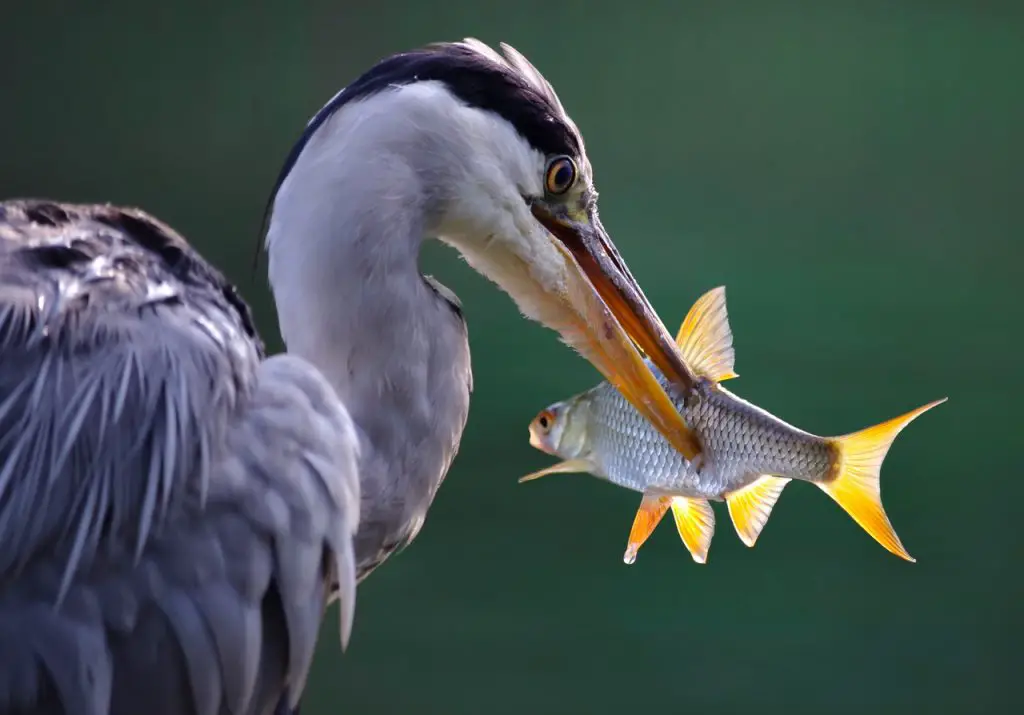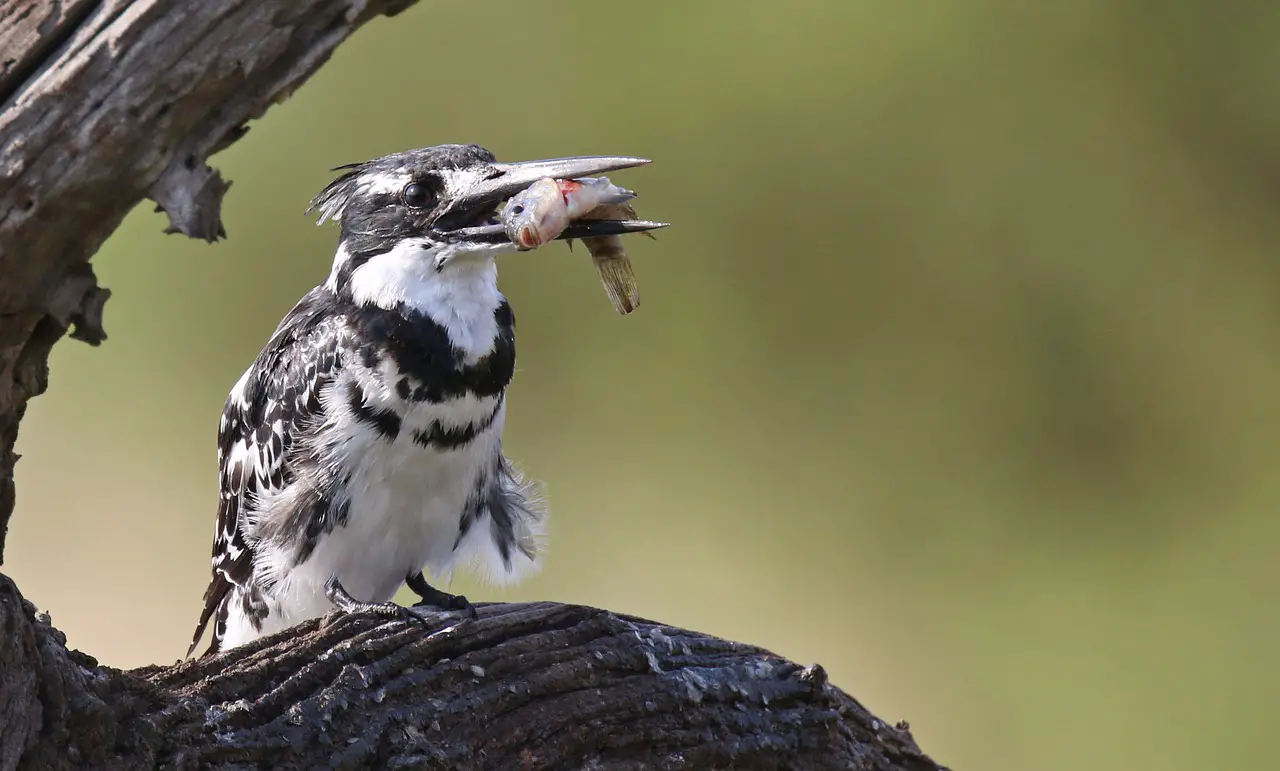Fish are an essential part of many birds’ diets, from tiny kingfishers to massive eagles and pelicans. Birds have some adaptations that help them to catch fish easily. Birds use different ways to enter the water and come away with billfuls of fish.
There are three ways that birds catch fish. Species including kingfishers and gannets dive into the water, while ospreys and eagles grab fish from the surface of the water. Ducks and grebes float on the water’s surface before diving. Body shape, bills, feet, and eyesight all help birds catch fish.
The different ways that birds catch fish are captivating. In this article, we look at how their bodies help them.
Do you know how owls hunt at night? Find out here

Birds that dive
Many fish-eating birds will fly in from above, waiting for the perfect time to strike while others wait on perches. They will enter the water at the correct angle, catch their prey and return to the air to repeat the process.
One of the most impressive to do this from the air are gannets. Gannets are excellent at diving into the water at the right angle to catch fish.
Kingfishers will wait patiently on perches before darting in and out of the water. These birds do their best to be at the right height, but this comes more naturally to long-legged waders like herons and egrets. While egrets are more active in the water, herons can stand statue-like, waiting for the fish to pass in range.
Feeding from the surface
Some birds that come in from above try their best not to enter the water at all. Ospreys and eagles will swoop in with their feet outstretched, grab the fish, and use their powerful muscles to lift it back into the air and away to somewhere they can feed. Ospreys are also known to move the fish around while flying to minimize wind resistance.
Black skimmers will fly close to the water with their bills open and scoop up what they can, using as little energy in the process as possible.
Diving from the surface
Loons, cormorants, grebes, and ducks all dive from the surface of the water. Surface divers will spend their time on the surface of a lake or the ocean, periodically diving down to hunt for prey. The loon can dive for as long as five minutes at a time, using their heavier bodies to descend deeper into the water and search for food.
Species like cormorants will also take big chances on larger fish that smaller birds can’t carry. Birdwatchers are often amazed to see them struggling with large adult salmon and somehow swallowing them whole. It doesn’t matter if they can’t take off for a while due to the extra weight.
Do you know how kestrels hunt? Find out in this article I wrote
Adaptations
Birds that feed on fish need the perfect bodies, which can vary depending on how they hunt. The physical adaptations of fishing birds are crucial for successful hunting. The body shape is essential, as are the differences in their bills and feet.
Birds that enter the water need to be able to do so safely and effectively. It also helps to have good eyesight to handle the refraction of the water.
Body shape
Body shape can make a huge difference. When chasing fish in the water, birds need a streamlined body to enter and come away with their prize. Many sea birds have longer necks, sleek bodies, and their legs are positioned further back. This can make them seem awkward when seen in the air or on land but aids them when in water.
The gannet takes this idea of the perfectly streamlined body to new levels. Gannets have pointed wings that they can tuck in as it dives into the water. Their dives can be from 100ft in the air with speeds up to 60mph. This allows them to dive deeper than other birds and reach more fish.
This is a dangerous activity, and gannets need to hit the water at the right angle to avoid breaking their necks. Gannets have other adaptations. They have air sacs in their face and chest that act like airbags, and they breathe mouth their mouths.
Diving birds have two ways of propelling themselves while in the water. Propulsion is achieved using the wings or the feet. Birds that use their wings include penguins, auks, and petrels, while ducks, loons, and grebes use their feet.
Do you know why birds lose their feathers? Find out here
Bills
A lot of fish-eating birds have different bills depending on their hunting methods. The skimmers have bills that look out of proportion. However, they are perfect for fishing on the top of the ocean.
The roseate spoonbill has a long, flat bill that it uses to swing through the water to catch fish, while the hooded merganser has a long, narrow bill that allows it to catch small fish. Bills come in many shapes and sizes, with the great blue heron using their long bill as a spear to catch fish.
Pelicans have big pouches to scoop up large amounts of fish. Smaller birds can also handle many fish. The Atlantic puffin is also able to handle many fish at once. It lines them up neatly with barbs on its tongue, taking large amounts back to the nest.

Feet
When it comes to feet, many surface divers have broad, webbed feet to handle the water better. Webbing helps propel the bird through the water when swimming and diving. Gannets, cormorants, and pelicans have webbing between all four digits, while ducks and geese have it only between the front digits. Sandpipers, herons, and ploves have a small amount of webbing.
Egrets, meanwhile, have bright yellow feet that move around in the water. Their feet could act as an enticing lure or to disturb prey in the silt.
Hawks and eagles rely on their powerful talons, with the osprey holding the fish straight ahead to remain aerodynamic while in flight.
Eyesight
The bird’s eyesight also plays a significant role in their chance of success. Birds that dive underwater need to be able to see where they are going and their prey. Most have a third nictitating eyelid that comes over and protects the eye while also allowing for as much visibility as possible.
Many diving birds can also judge distance perfectly, correcting for the refraction of the water. When light travels into the water, it bends, and their correction enables them to catch their prey. Gannets have eyes positioned forward on their heads, giving them binocular vision, which helps them to dive.
Stealing food
Hunting for fish is easy if you have the skills and the physical adaptations to succeed. Many birds have evolved to hunt fish and provide an excellent service for controlling populations. Other species, however, realize that they can get a good meal by stealing fish rather than hunting for them.
Gull species will eat any fish that washes up on a shore. Eagles will see if they can frighten other birds – either younger eagles or osprey – into giving up their catch.
The parasitic jaeger is a kleptoparasite and will spend its time stealing the catches of other birds. This allows them to save energy and get a good meal.

